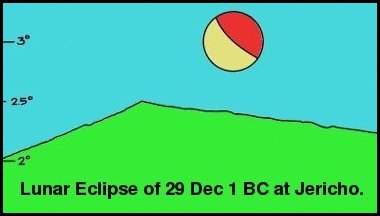
by John P. Pratt
24 Jun 2018, 1 Birth (M,UM), 1 Prime (UV), Resurrection (P), 1 Summer (E)
©2018 by John P. Pratt. All rights Reserved.
| 1. Traditional Dating |
| 1.1 Biblical Evidence |
| 1.2 LDS Tradition |
| 2. Book of Mormon |
| 2.1 Resurrection Date |
| 2.2 Count Back to Birth |
| 3. Sacred Calendars |
| 3.1 Hebrew Calendar |
| 3.2 Sacred Round |
| 3.3 Venus Calendar |
| 3.4 Mercury Calendar |
| 4. Conclusion |
| Notes |
There has been much controversy over the date of the birth of Jesus Christ. The Biblical account only gives a few clues and they have seemed inconsistent. Most scholars believe Christ was born about 6-4 BC. LDS leaders have stated their belief that the founding date of the LDS Church marked the anniversary of His birth but many Mormon scholars prefer other dates. This article first briefly reviews the scanty Biblical evidence on which the scholarly dates are based, then considers the Book of Mormon date, and then discusses a new method of dating the birth of Jesus Christ based on a network of dates on sacred calendars. Together they provide compelling evidence that the Savior was indeed born on the evening preceding Thu 6 Apr 1 BC (all dates herein are Gregorian).
In ancient times the date of birth of a child often was not recorded in any official manner. In the case of Jesus Christ, His birth was purposely kept hidden and obscure from everyone except a few shepherds and some wise men who knew how to read sacred signs in the heavens. Indeed, when King Herod discovered the child had been born, he immediately tried to have the baby killed because he feared his kingship would be threatened. Let us now look at how an approximate date of birth is derived by scholars from the Bible and other historical evidence.
Luke attempted to ascertain the approximate date from eyewitnesses, especially from His mother Mary (Luke 1:2; 2:19). He tells us that the birth was during the reign of Augustus Caesar, during the governorship of Quirinius (also called Cyrenius) when Joseph and Mary traveled from Nazareth to Bethlehem as per a decree of Caesar. Those data points cause problems because it is not known with certainty who was governor during some possible years for His birth and the registration decree has not been recognized.
 |
The main reason that scholars assume the early Church fathers were wrong was because of a statement by the Jewish historian Josephus that implies that King Herod the Great, who was alive at the time of Jesus' birth, died in 3 BC. It is also stated in his history that there was a lunar eclipse visible shortly before his death and because there was such an eclipse in March of 4 BC, they assume that Josephus was also a year late and pushed the date of Herod's death back to 4 BC. They feel that this date is confirmed because Herod's sons claimed to have begun to reign in 4 BC, so they propose that Jesus was born about 6-5 BC because Herod had all the baby boys killed who were age 2 and under (Matt. 2:16).
It has since been shown that Josephus most likely had two sources that gave the death date of King Herod. One said 3 BC and the other said AD 1, three years later. Perhaps because of the claim of Herod's sons, he chose the earlier date, but now the evidence favors the later date and that his sons reckoned their regency from when Herod's son Antipater began to rule along with Herod. Such antedating was a common practice at the time to make reigns appear longer. Herod most likely died about February, AD 1 after a lunar eclipse in December, 1 BC.[2]
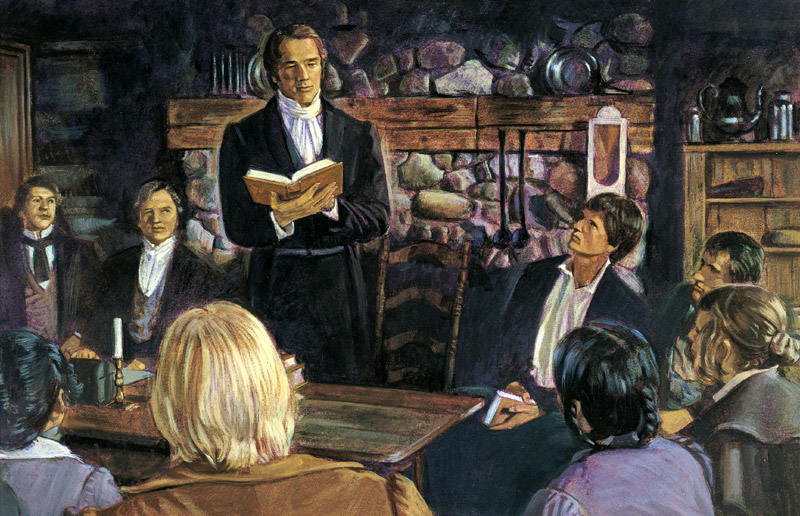 |
LDS scholars critical of this tradition note that the language of the section "since the coming of our Lord" was common at the time and only meant that the year was 1830.
The evidence presented hereafter in this article strongly favors the words of the presidents of the LDS Church who stated that the correct day on which to celebrate the birth of Christ (on our Gregorian Calendar) is 6 April.
The Book of Mormon gives some very precise information, accurate to the very day, about both the birth and date dates of the Savior Jesus Christ. This information has been largely overlooked even by LDS scholars. Let's look first about what the Bible says about the dates of the death and resurrection of Jesus, and then how it can be used with the information from the Book of Mormon.
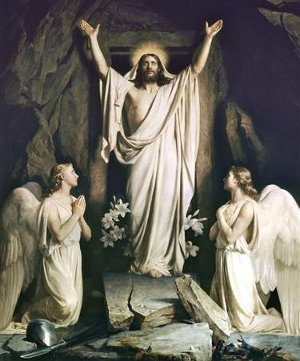 |
As mentioned above, Luke tells us that John the Baptist began his ministry in AD 29, at which time the Savior was baptized. Later Jesus began His public ministry on Passover (Sat 6 Apr) in AD 30 (John 2:23). The gospels describe a three-year ministry, with the Savior being crucified at Passover (in AD 33). All four gospels record that Jesus died on a Friday, called the "preparation" at the time, meaning the preparation for the Saturday sabbath. Scholars unnecessarily muddy the interpretation of that word, but there is not really any doubt about its meaning. Then all four gospels agree that on the following Sunday morning before dawn His tomb was found empty by the women coming to finish preparing his body after they had rested on the (Saturday) sabbath day. All of these points are discussed in detail in an earlier article.[4]
As Sir Isaac Newton pointed out, this account is backed up by astronomical calculations because the accounts also record that the Savior's death occurred at the time of Passover (full moon) and that the Judeans (called "Jews" in the KJV) held Passover on Saturday that year. That fits perfectly the lunar phase in the year AD 33, but not at all AD 31 or 32. Scholars are quick to point out, however, that the astronomy also fits the year AD 30. Because they prefer an earlier birth date for Jesus, they reject the Biblical date of AD 33 for the death and Resurrection, and choose AD 30 instead. Thus, their chronology is built on that of Josephus rather than the Bible.
Turning now to the Book of Mormon, we are told that darkness prophesied to occur at the death of the Savior took place on the 4th day of their 34th year (3 Nephi 8:5). Thus, the Nephites give the exact date of the Savior's death, but in order to understand what date on our calendar is referred to, we need to understand the Nephite Calendar.
The Nephites changed their calendar to begin at the time of the sign given of the birth of Jesus Christ (3 Nephi 2:8). The most obvious interpretation of that statement is that "day one" of "year one" of the new reckoning was the day after the night which was light all night, when Christ was born. If so, then because Christ died on day 4 of year 34, He lived 33 Nephite years and 3 days.
What calendar did the Nephites use? They kept the law of Moses, so our first guess could be the Hebrew Calendar. But that does not work because on the Hebrew Calendar, Jesus was crucified on the 14th day of the lunar month (the Passover full moon), not the 4th day.
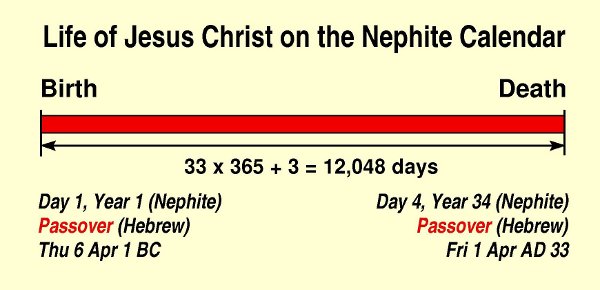 |
Now let us look at four different sacred calendars which the Lord appears to be using to time holy events, including the birth and resurrection of Jesus Christ. The compelling evidence that these two dates are correct is that all of these calendars agree not only that those two events happened on holy days on those calendars, seven other key events in the life of Jesus Christ also happened on designated holy days on all of those calendars! Several dates of events in His life are discussed in this article. If more information as to how they were derived is desired, look up the date of interest in the Religious Chronology on my website which provides links to relevant articles.
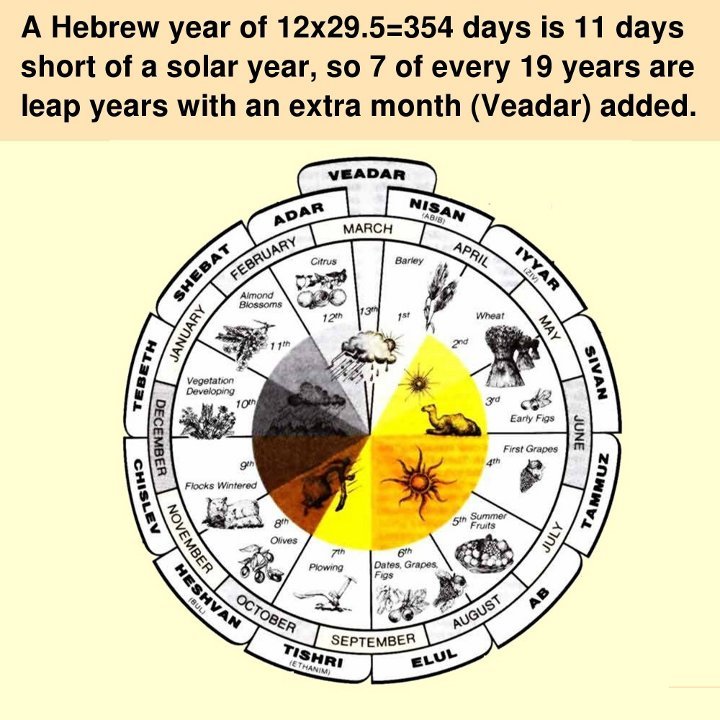 |
Let us begin identifying key dates by using the dates of the birth, death, and resurrection of Jesus Christ already proposed. At the spring Passover ritual an unblemished lamb was sacrificed on the afternoon of 14 Nisan, called the "preparation of the Passover" or Lamb's Day in my work (major holy days are in boldface italics and minor holy days are in italics). The day Fri 1 Apr 33 was indeed 14 Nisan and the Savior died about 3 pm, just when the Passover lambs were being sacrificed by the Judeans (John 19:14)![7]
The Sunday morning of the Resurrection was also a day for a special rite on the Hebrew Calendar. It is called the "Waving of the Omer", which was an offering of the firstfruits of barley from the ground. Paul pointed out that it symbolized the resurrection of Christ, who was the "firstfruits" of the dead to rise (1 Cor 15:20). In my work, this sacred day is simply called "Easter" because after the Resurrection its significance became clear, and today the usual word for the day to celebrate it is called Easter.
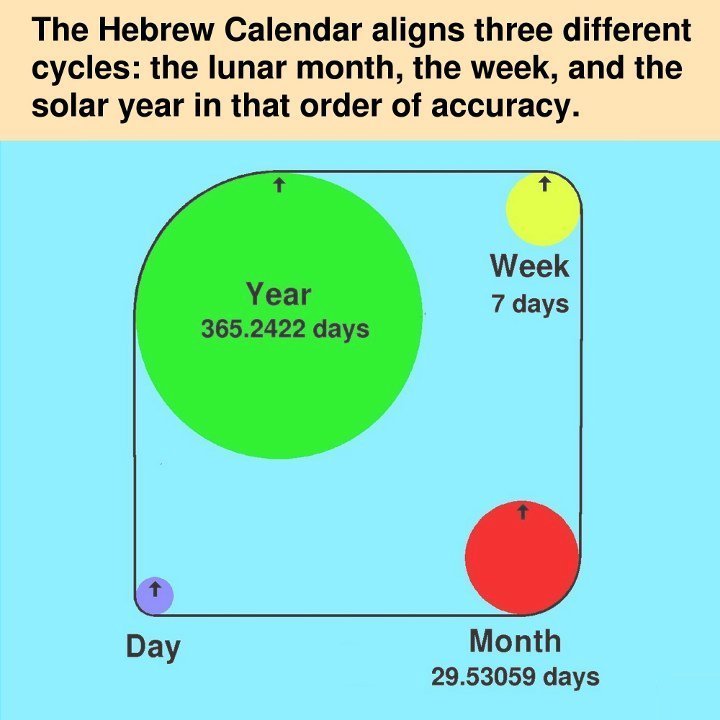 |
The evening proposed for the birth of Christ was the beginning of Passover (15 Nisan). Thus, Passover not only celebrated the birth of the nation of Israel at the Exodus, it foreshadowed the birth of the Savior. On the Hebrew Calendar He lived exactly 33 years, being born as 15 Nisan began and dying as 14 Nisan ended!
Now let us turn to the day of the Savior's baptism. There is one holy day on the Hebrew Calendar which is ideal to make commitments to God. It is the Day of Atonement. It is the tenth day of the first month of autumn (10 Tishri) and comes at the end of ten days of repenting of sins and making reconciliation with God. It is a day when John the Baptist would have been giving a big sermon and inviting all to be baptized. It is the holiest day of the Hebrew year no matter what day of the week it fell on, but in AD 29 it was on the weekly sabbath: Sat 6 Oct 29. It has been proposed in my work that Jesus was baptized on that day.
The precise day on which the Savior began his public ministry by teaching and performing miracles at the temple was recorded. It was on Passover, which would have been in AD 30, on Sat 6 Apr 30 (John 2:23).
The transfiguration of Jesus on the mount with Peter, James and John was also most likely on Atonement in AD 32. That would have been on Sat 2 Oct 32. That was the Feast of Tabernacles on the Enoch Calendar and the apostles suggested making tabernacles for Jesus, Moses, and Elijah who were all present (Matt. 17:4).
Each of these proposed dates was on a holy day on the Hebrew Calendar. Now let us look at other sacred calendars totally independent of the Hebrew seeking confirming evidence that these dates are correct.
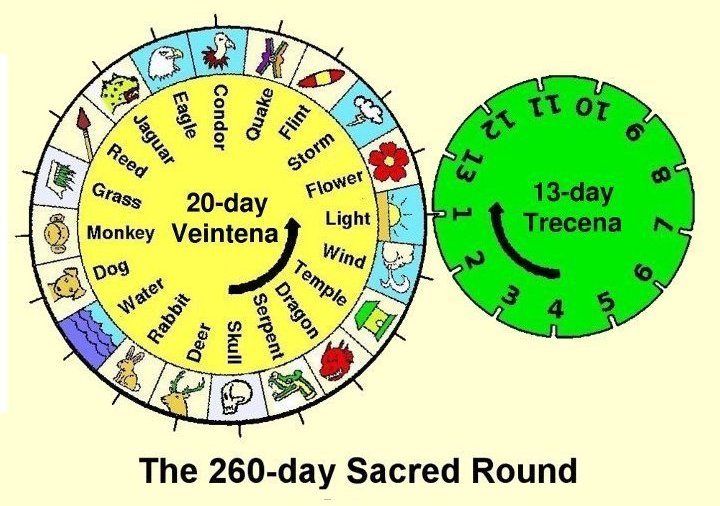 |
The Sacred Round consists of a fixed cycle of 260 days which in turn is made up of two shorter cycles: a trecena of 13 days numbered 1 to 13 and a veintena of 20 days each of which has a picture associated with it. The first day is 1 Light, followed by 2 Wind and then 3 Temple (see Figure 3). After 13 x 20 = 260 days the cycle begins to repeat. It never inserts a leap day, so it is a powerful tool for dating because once one date has been established, all other dates in history are determined.
How does the Sacred Round relate to our calendar? Three scholars (with initials G, M, and T) each suggested a way to link it to our Gregorian Calendar and their answers were within a six-day range. A compromise (the GMT) was chosen which was in that range, but differed from all three of their dates. In my work it is suggested that the correct correlation to our calendar differs by one day from the GMT for the following reason.
The Aztecs of Mexico preserved the tradition that a white and bearded god called the Feathered Serpent came to visit their ancestors in the first century AD. Their description of him closely matches that of the Savior who visited the Nephites at that time. For example, he was sacrificed when in his prime, went to the underworld, overcame death, and resurrected as a god after a few days. Moreover, they said he was born on the day 1 Reed of the Sacred Round.
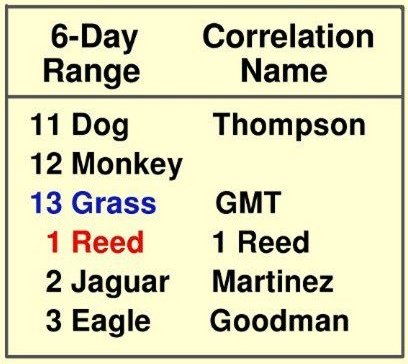 |
If Wed 5 Apr 1 BC is matched to the day 1 Reed on the Sacred Round, then that day fits right into an available slot for the possible days for the two calendars to align (see Figure 4). Accordingly, that "1 Reed" correlation has been proposed and is used in my work.
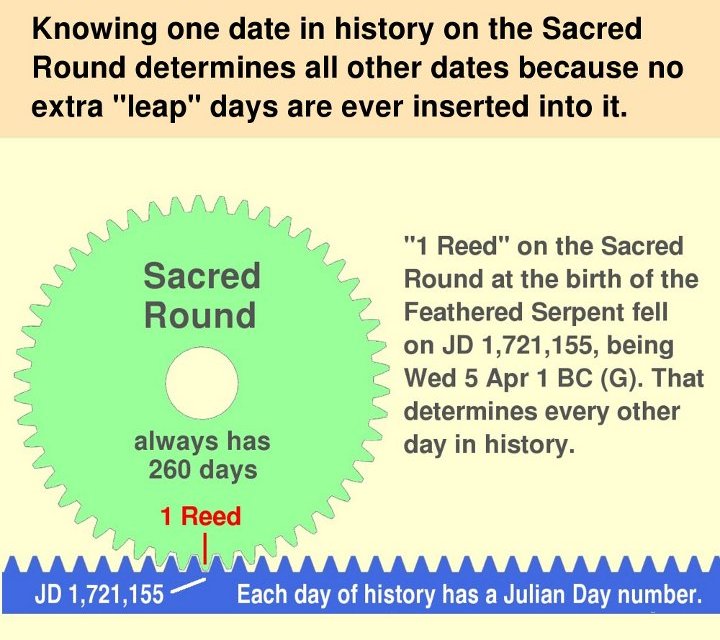 |
Now that the 1 Reed correlation of our calendar to the Sacred Round has been discovered, let us see where the other dates proposed from the Bible fall on the Sacred Round. To appreciate them, we need to know that all dates with the numbers 1 and 13 are holy, and those with the pictures Light, Wind, Temple, Serpent, Reed, Eagle and Lord are major holy days.
By simply calculating cycles of 260 days, we see that the proposed day for the baptism of Jesus falls on 13 Water. "Water" is an ideal symbol for baptism and 13 marks the highest or culmination of Water. Of all 260 days on the Sacred Round, what could be a better day that for the Savior to have been baptized? Thus, the Sacred Round is a second witness to the correctness of the day proposed for His baptism.
Similarly, the day proposed for His transfiguration, when He shown brightly like the sun, was 13 Light. As was the date of the Savior's baptism, again this symbolism is perfect, being the height of light.[9] The fact that both of these dates are so meaningful on the Sacred Round virtually eliminates the possibility that they were chance occurrences. These sacred events were clearly planned far ahead.
The date of the beginning of the Savior's public ministry fell on 13 Monkey on the Sacred Round. The symbolism of the Monkey is not as well understood, but it seems to be related to a new beginning, being the first glyph in the second half of the 20-day veintena.
The preaching in the spirit world and the Resurrection were on the same day on the Sacred Round: 13 Temple, being from 6 a.m. on Saturday to 6 a.m. on Sunday morning. Again 13 represents the highest point. Each picture on the Sacred Round represents a step of life. "Temple" represents "Birth" and "Reed" symbolizes "Resurrection". Thus the Savior was born on 1 Reed, meaning resurrection, and resurrected on 13 Temple, meaning birth. It appears that these two related date pictures were purposely swapped, perhaps to keep the dates secret until they occurred. In any case, they are clearly meaningful. Thus, all of the dates proposed from the Bible and Book of Mormon turn out to be meaningful holy days on the Sacred Round. That is strong confirming evidence that the dates are correct.
In the last chapter of the Book of Revelation, Jesus identifies Himself with the planet Venus, the bright Morning Star (Rev. 22:16). What did He mean by that?
The Aztecs answered that question, saying that the different phases of Venus as both Evening and Morning Star symbolized the life of the Feathered Serpent (Jesus Christ). Figure 6 illustrates the phases as seen from the earth. Venus is born at "Birth" when it first rises in the west as the Evening Star, being rather dim. This is like Jesus being born in obscurity. Then it gradually grows higher and brighter until it is brightest at "Prime". Then it quickly plunges into the earth at "Death". There it conquers the forces of evil in the underworld and resurrects in only a few days as the bright Morning Star (at "Resurrection").
The Aztecs said that when the Feathered Serpent resurrected, that Venus also resurrected at the same time when it rose as the Morning Star. It was that statement that caught my attention some 35 years ago because I could check to see if it was correct. That is, I knew the date of the Resurrection to have been Sun 3 Apr 33 and I had tables of the phase of Venus for every date in history. To my astonishment, Venus was indeed rising as Morning Star on that date. To me it meant that the Aztecs had correctly kept a true teaching of the Savior for over a thousand years. Years of research then led to the discovery of the Venus Calendar.
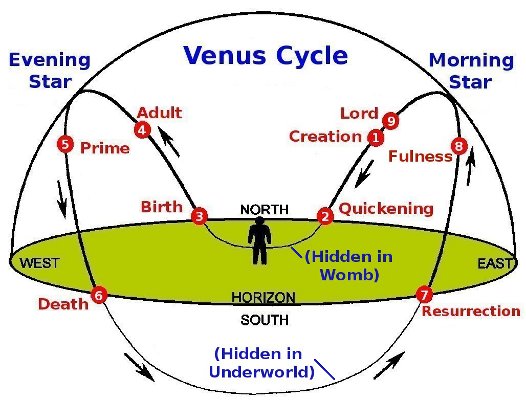 |
All of the events in the life of Jesus discussed so far also fell on holy days on the Venus Calendar. His birth was on 1 Lord, baptism on 0 Prime (which represents being spiritually reborn, which in turn is represented by baptism), His ministry began on 0 Fulness, the Transfiguration was on 0 Adult, and the Resurrection was on 1 Resurrection (as remembered by the Aztecs!). Thus, all of these events were on holy days and two of them (baptism and resurrection) were on the very day symbolized by the phase!
But there is more: dates can now be suggested for other events. Two more important days were when the angel told Joseph and Mary to flee to Egypt because Herod wished to kill their son, and also when he told them to return because Herod had died (Matt. 2:13). It turns out that there are two reasonable dates which can be proposed as correct for both fleeing to Egypt and returning.
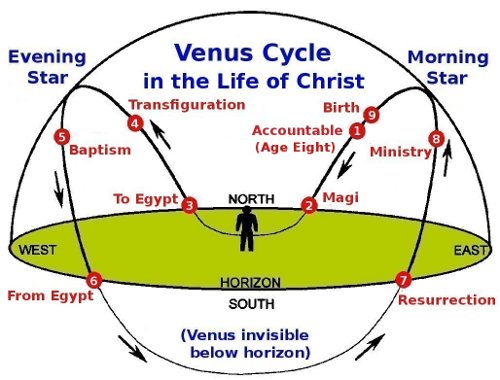 |
The return most likely began on Thu 22 Mar AD 1, about a month after the death of King Herod. On the Venus Calendar it was 1 Death, which is the perfect end date for the end of a journey which began on 1 Birth. It was also the Hebrew Consecration, for choosing of the Passover Lamb (10 Nisan)!
Now an unexpected pattern is emerging. Each of these seven events occurred on different holy Venus orbital points. What if there are nine events, with the other two occurring at the other two orbital points, namely, Creation and Quickening? And, like these first seven, what if those events were also on Hebrew holy days?
Making an exhaustive search of all dates during the Savior's life indeed leads to two such dates, which fortunately happened to occur during times when a suggested event can be proposed. First, the eighth birthday of the Savior on the Hebrew Calendar (Passover of AD 8, being Tue 8 Apr 8) was on the Venus day 1 Creation. That matches the LDS teaching that a child becomes accountable for his actions at age 8 (D&C 68:25-27). The fact that this Venus date occurs exactly on His eighth birthday strongly suggests that the Savior's becoming accountable for His actions was a key date in his life.
The final date to complete this pattern was after sunset on Sat 27 May 1 BC, which was the Hebrew Firstfruits and also was 1 Quickening (Venus). What could that event have been? It seems perfect for the visit of the wise men! That was not two years after the Savior's birth as often assumed based on Herod having two-year-olds killed. A newborn child was considered to be in its first year at birth, so "age two" really meant what we would call "age one". Thus, we can tentatively propose that day for a key event, most likely being the wise men's visit. Figure 7 shows how these nine proposed events, holy on all three calendars, could have all occurred at different Venus orbital points. Truly Venus was indeed His planet!
 |
Table 1 summarizes ten religious events in the life of Jesus all occurring on holy days on the Hebrew, Sacred Round, and Venus Calendars. That is truly phenomenal and constitutes strong and even compelling evidence that all of the dates are correct. We were only searching for the birth date of Jesus, but this network of interlocking dates all testify of each other, including the date of birth.
Now let us turn to another planet which is the other (dim) evening and morning star. It has the same phases of Venus, but its cycle is only about 117 days, about a third of a year. Mercury is the swift messenger that goes around quickly enough to complete several cycles in as short a time as the ministry of Jesus Christ. But it never ventures far from the sun, so it is never bright.
The Mercury Cycle of 117 days equals 9 trecenas of 13 days each. It also has the same nine phases as Venus and all begin on a day "1". Thus, every day 1 and 13 (the "0") on the Sacred Round are also Mercury holy days. Thus, it is not surprising that all of the nine events discussed so far also occurred on Mercury holy days because they all occurred on a day 1 or 13 of the Sacred Round.
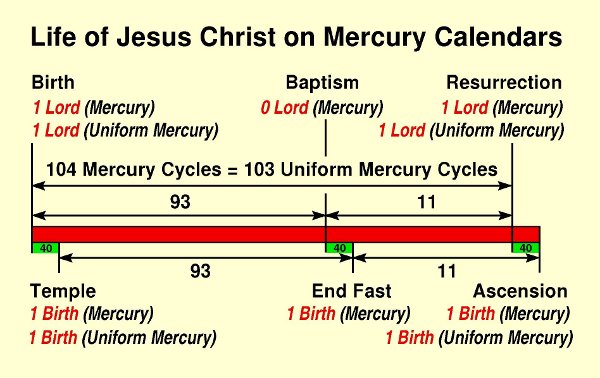 |
Another strong witness that these dates were planned is that there are three 40-day intervals noted in the life of Jesus. On the 40th day of His life, like all male infants, He was taken to the temple to be presented to the priest. After His baptism, He fasted for 40 days. Finally, He taught the apostles for forty days after the Resurrection (Acts 1:3). It turns out that all of these intervals began at the orbital point Lord and all ended on the day 1 Birth on the Mercury calendar (see Figure 8, where Uniform Mercury Calendar refers to one which never corrects the 117-day Mercury Cycle to average the true value). There seems to be no way that all of this could have happened by chance, so together both of these Mercury calendars truly testify of the correctness of these dates.
In order to firmly establish the birth date of the Savior, first the clearly indicated Biblical Resurrection date is chosen to be the principal anchor date. Then the birth date of Wed 5 Apr 1 BC after sunset is proposed by counting backwards from the death date given in the Book of Mormon to the date when the sign of Christ's birth was given. LDS leaders have said that 6 April is the day on our calendar to celebrate His birth, which is actually on the same day considering that the Hebrew day begins on the previous evening.
Four sacred calendars are introduced and briefly described: the Hebrew, Sacred Round, Venus, and Mercury. Each has holy days and the last three are independent of the Hebrew. It is shown that nine holy dates on the Hebrew Calendar are also holy days on all of those calendars, providing compelling evidence of the correctness of all of the dates. Truly the sun, moon and planets, on which these calendars are based, all testify of Christ!